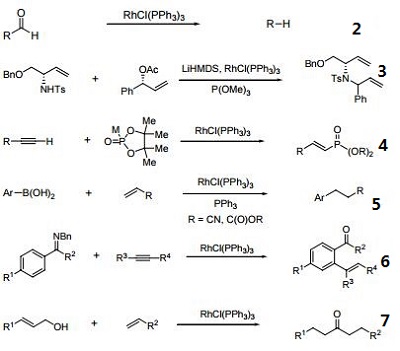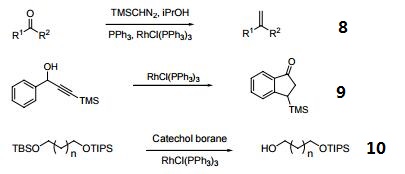| Identification | More | [Name]
Chlorotris(triphenylphosphine)rhodium(I) | [CAS]
14694-95-2 | [Synonyms]
CHLOROTRIS(TRIPHENYLPHOSPHINE)RHODATE (I)
CHLOROTRIS(TRIPHENYLPHOSPHINE)RHODIUM(I)
DECARBON
RHODIUM(I) TRIS(TRIPHENYLPHOSPHINE) CHLORIDE
RHODIUM TRIS(TRIPHENYL-PHOSPHINE)CHLORIDE
TRIS(TRIPHENYLPHOSPHINE)CHLORORHODIUM
TRIS(TRIPHENYLPHOSPHINE)RHODIUM(1) CHLORIDE
TRIS(TRIPHENYLPHOSPHINE)RHODIUM(I) CHLORIDE
TRIS(TRIPHENYLPHOSPHINE)RHODIUM(I) CHLORIDE POLYMER BOUND
WILKINSON CATALYST
WILKINSON'S CATALYST
(sp-4-2)-rhodiu
Rhodium, chlorotris(triphenylphosphine)-
Rhodium, chlorotris(triphenylphosphine)-, (SP-4-2)-
Tris(triphenylphosphine)chlororhodium(I)
Tris(triphenylphosphine)rhodium chloride
Tris(triphenylphosphine)rhodium monochloride
Tris(triphenylphosphine)rhodiumchloride
Tris(triphenylphosphino)chlororhodium
Chlorotri (triphenylphosphine) rhodium | [EINECS(EC#)]
238-744-5 | [Molecular Formula]
C54H45ClP3Rh | [MDL Number]
MFCD00010016 | [Molecular Weight]
925.21 | [MOL File]
14694-95-2.mol |
| Chemical Properties | Back Directory | [Appearance]
magenta crystals | [Melting point ]
245-250 °C (dec.)
| [Boiling point ]
>170°C | [density ]
1.363; d 1.379 | [vapor pressure ]
0Pa at 25℃ | [storage temp. ]
2-8°C
| [solubility ]
Soluble in most solvents (e.g. benzene, ethanol, chloroform, dichloromethane) but with phosphine dissociation. Reacts with O{2} in solution | [form ]
Crystalline Powder | [color ]
Red-brown to maroon | [Water Solubility ]
insoluble | [Hydrolytic Sensitivity]
4: no reaction with water under neutral conditions | [Sensitive ]
air sensitive | [Merck ]
14,10047 | [BRN ]
4581440 | [Exposure limits]
ACGIH: TWA 1 mg/m3
NIOSH: IDLH 100 mg/m3; TWA 0.1 mg/m3 | [InChIKey]
QEYYHUJFSQCTAE-UHFFFAOYSA-M | [LogP]
5.69 at 20℃ | [CAS DataBase Reference]
14694-95-2(CAS DataBase Reference) | [NIST Chemistry Reference]
chlorotris(triphenylphosphine)rhodium(14694-95-2) | [EPA Substance Registry System]
14694-95-2(EPA Substance) |
| Safety Data | Back Directory | [Hazard Codes ]
C,Xi | [Risk Statements ]
R34:Causes burns.
R36/38:Irritating to eyes and skin . | [Safety Statements ]
S22:Do not breathe dust .
S24/25:Avoid contact with skin and eyes .
S37/39:Wear suitable gloves and eye/face protection .
S26:In case of contact with eyes, rinse immediately with plenty of water and seek medical advice .
S15:Keep away from heat . | [RIDADR ]
1759 | [WGK Germany ]
1
| [F ]
8-10-23 | [TSCA ]
Yes | [HS Code ]
28439090 |
| Questions And Answer | Back Directory | [Reactions]
- A homogeneous hydrogenation catalyst which operates under mild conditions.
- Catalyst for the decarbonylation of aldehydes.
- Catalyst for regio- and stereoselective allylic substitution reactions.
- Alkyne hydro-phosphorylation
- Heck-type reaction with α,β-unsaturated esters.
- Alkyne arylation
- Allylic alcohol-olefin coupling.
- Terminal alkenes from ketones.
- Rh-catalyzed isomerization of α-aryl propargyl alcohols to indanones.
- Reductive deprotection of silyl groups.


|
| Hazard Information | Back Directory | [Chemical Properties]
magenta crystals | [Uses]
Homogeneous hydrogenation catalyst. | [Uses]
suzuki reaction | [Uses]
Tris(triphenylphosphine)rhodiu is also known as Wilkinson's catalyst and is commonly used to catalyze the hydrogenation of alkenes. Tris(triphenylphosphine)rhodiu is also used in the catalytic hydroboration of alkenes with catecholborane and pinacolborane and the selective 1,4-reduction of α, β-unsaturated carbonyl compounds.
| [Flammability and Explosibility]
Nonflammable | [reaction suitability]
core: rhodium
reagent type: catalyst | [Purification Methods]
It forms dark burgundy crystals from hot EtOH after refluxing for 30minutes. When the solution is heated for only 5minutes, orange crystals are formed. Heating the orange crystals in EtOH yields red crystals. Crystallisation from Me2CO gives the orange crystals. The two forms have similar IR spectra, but the X-ray diffraction patterns are slighly different. [Osborne et al. J Chem Soc (A) 1711 1966, Osborne & Wilkinson Inorg Synth X 67 1967, Bennett & Donaldson Inorg Chem 16 655 1977.] The solubilities are as follows: in CH2Cl2 ~2% (25o), in toluene 0.2% (25o), and less soluble in Me2CO, MeOH, BuOH and AcOH, but insoluble in pet ethers and cyclohexane. It reacts with donor solvents such as pyridine, DMSO and MeCN. |
|
|